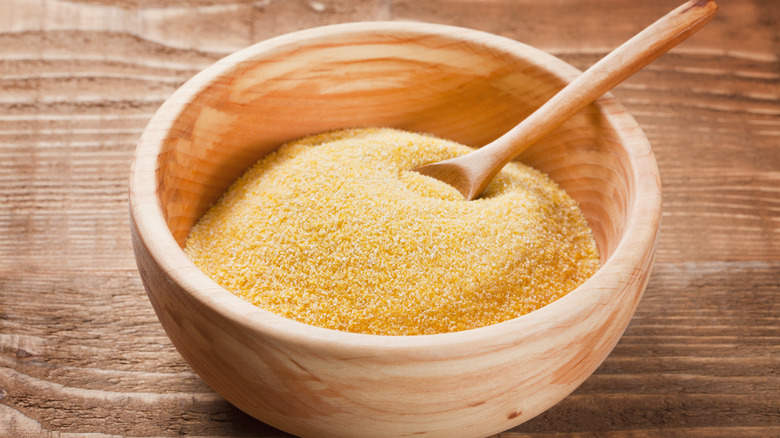Grits: A Southern staple that seems to last forever in the pantry. But what happens when you discover that forgotten bag of grits tucked away in the back of your cupboard, well past its “best by” date? Can expired grits actually make you sick?
No, expired grits are unlikely to make you sick if they’ve been stored properly.
While it’s true that grits can go bad, they have an impressively long shelf life when kept in a cool, dry place.
Here’s what you need to know about expired grits:
- Dry, uncooked grits can last 1-2 years past their printed date
- Proper storage is key to maintaining quality and safety
- Signs of spoilage include mold, off-odors, or unusual texture
- Consuming truly spoiled grits could potentially cause mild digestive issues
So, before you toss that old bag of grits, take a closer look. Chances are, they’re still perfectly fine to eat.
Let us learn more about how to store and keep grits safe so that you can get the most out of this versatile pantry staple.
Contents
Do Grits Expire?
Grits do go bad, but they last a long time. Uncooked grits can stay good for up to five years if stored right. The type of grits matters too. Instant grits keep for 2-5 years, while stone-ground grits last about a year.
But how can you tell if your grits have gone bad? Look out for these signs:
- Mold: Any fuzzy spots mean toss them out.
- Weird smell: Fresh grits shouldn’t stink.
- Off color or taste: If it looks or tastes odd, don’t eat it.
Proper storage is key to keeping grits fresh. Here’s what to do:
- Keep them cool and dry
- Use airtight containers
- Avoid moisture at all costs
I’ve found that mason jars work great for storing grits. They keep air and bugs out while letting you see what’s inside.
Cooked grits are a different story. They spoil fast, so eat them within a week. Always keep cooked grits in the fridge in a sealed container.
Can you eat grits past their “best by” date? Often, yes. That date is about quality, not safety. If stored well and showing no signs of spoilage, they’re likely fine to eat.
But remember, when in doubt, throw it out. It’s not worth getting sick over some old grits.
What Are the Factors That Affect Grits Expiration?

Several things impact how long grits last. Let’s break them down:
Form of Grits
The type of grits you have matters a lot. Here’s a quick rundown:
| Type of Grits | Shelf Life |
|---|---|
| Instant Grits | 2-5 years |
| Stone-ground Grits | Up to 1 year |
Why the big difference? Instant grits are more processed, which helps them last longer. Stone-ground grits keep more of the whole grain, but that means they can go rancid faster.
Packaging and Storage
How you store your grits is crucial. Here are some tips:
- Use airtight containers: This keeps moisture and bugs out.
- Store in a cool, dry place: Heat and humidity are grits’ enemies.
- Keep away from light: Sunlight can degrade grits over time.
I once made the mistake of storing grits in a damp basement. They got moldy in no time. Learn from my goof and keep them somewhere dry.
Presence of Preservatives
Some grits have preservatives added. These can help them last longer, but they’re not magic. Even with preservatives, grits can still go bad if not stored right.
Natural stone-ground grits often lack preservatives. That’s why they don’t last as long as instant grits.
Temperature Fluctuations
Big swings in temperature can hurt your grits. Here’s why:
- Heat can make grits go rancid faster
- Cold isn’t usually a problem, unless it leads to condensation
- Frequent changes can cause moisture buildup
I keep my grits in a pantry that stays pretty much the same temp year-round. It’s worked well for me.
Expiration Date and Lot
The date on the package matters, but it’s not the whole story. Here’s what to know:
- “Best by” dates are about quality, not safety
- Lot numbers can help track recalls if needed
- Older lots might not be as fresh, even if not expired
I always write the purchase date on my grits containers. It helps me use the oldest ones first.
Can Grits Go Bad Before the Expiration Date?
Yes, grits can go bad before their expiration date. It doesn’t happen often, but it’s possible. Here’s what you need to know:
Improper Storage Conditions
Bad storage is the main culprit for early spoilage. Watch out for:
- Moisture: It leads to mold growth
- Heat: It can make grits go rancid
- Pests: Bugs can get into poorly sealed containers
I once left a bag of grits open in my pantry. Ants found it in no time. What a mess.
Temperature Fluctuations
Big temp changes are bad news for grits. They can cause:
- Condensation inside the package
- Faster spoilage due to moisture
- Changes in texture or flavor
Keep your grits somewhere with a steady temperature. A kitchen cabinet away from the stove works well.
Cross-Contamination
This is a big risk for cooked grits. Here’s how it happens:
- Using dirty utensils
- Storing near raw foods
- Not sealing containers properly
Always use clean spoons and store cooked grits separately from raw foods.
How to Store Grits For Long Term?

Follow these tips to store grits for long time:
Choose the Right Container
Pick containers that are:
- Airtight
- Food-safe
- Easy to clean
I love using glass jars. They keep grits fresh and let me see how much I have left.
Keep in a Suitable Place
The best spot for grits is:
- Cool
- Dry
- Dark
- Away from strong odors
A pantry or kitchen cabinet works great. Just keep them away from the stove or dishwasher.
Avoid Moisture
Moisture is the enemy of grits. To keep it away:
- Use a dry scoop when measuring
- Don’t store in the fridge (unless cooked)
- Keep lids on tight
I once spilled water near my grits jar. I dried it off right away to prevent any moisture getting in.
Label Containers
Always label your grits with:
- Type of grits
- Purchase date
- “Best by” date
This helps you use older grits first and know what you’re grabbing.
Consider Refrigeration for Longer Storage
For stone-ground grits, the fridge can help. Here’s why:
- Slows down rancidity
- Keeps bugs away
- Extends shelf life
Just make sure to use an airtight container to prevent moisture.
Regular Inspection
Check your grits now and then. Look for:
- Weird smells
- Changes in color
- Signs of pests
Catching problems early can save you from wasting food.
Can You Eat Expired Grits?
The answer isn’t simple. Here’s what you need to know:
Check for Spoilage Signs
Before eating expired grits, always check for:
- Mold: Any sign of mold means toss them out
- Off smells: Fresh grits shouldn’t stink
- Weird colors: If it looks off, don’t risk it
I once found a bag of grits way past its date. They looked and smelled fine, so I cooked some up. They tasted great.
Consider the Type of Grits
Different types of grits last for different times:
- Instant grits: Usually fine past the date if stored well
- Stone-ground grits: More likely to go bad, check carefully
When in doubt, cook a small amount and taste test before using a lot.
Use Your Best Judgment
Trust your senses. If anything seems off:
- Don’t risk it
- When in doubt, throw it out
- Your health is worth more than old grits
I always give my grits a good look and sniff before cooking. It’s saved me from using bad ones more than once.
Will Expired Grits Make You Sick?
Potential Health Risks
Eating expired grits can pose some risks:
- Mold toxins: Some molds make harmful substances
- Rancid oils: Can cause stomach upset
- Bacteria growth: Especially in cooked grits
But here’s the thing: properly stored, dry grits rarely make you sick. The risk is low if they look and smell okay.
How to Mitigate Risks
To stay safe with older grits:
- Check for signs of spoilage
- Cook thoroughly
- Store properly
- Trust your nose and eyes
I once ate grits a year past their date. They were fine because I stored them well and checked before cooking.
Do Grits Go Bad?
Yes, grits can go bad. But it takes a while if you store them right. Let’s look closer:
Signs of Spoiled Grits
Watch out for these red flags:
- Mold: Any fuzzy spots mean toss them
- Weird smell: Fresh grits shouldn’t stink
- Off color: If it looks wrong, don’t eat it
- Bugs: Little critters mean it’s time to say goodbye
I once found weevils in an old bag of grits. Straight to the trash it went.
Impact of Spoilage on Health
Eating spoiled grits can make you sick. Here’s how:
- Mold toxins can cause allergic reactions
- Rancid grits might upset your stomach
- Bugs… well, that’s just gross
Properly stored grits rarely cause issues. Just use your senses before cooking.
FAQ
How Long Do Grits Last After Cooking?
Cooked grits don’t last long. Here’s the scoop:
- In the fridge: 3-4 days tops
- At room temp: 2 hours max
Always store cooked grits in the fridge in a sealed container. And reheat them thoroughly before eating.
Do Uncooked Grits Need to Be Refrigerated?
Nope. Dry, uncooked grits don’t need to be in the fridge. In fact, the fridge can introduce moisture, which is bad news.
Store them in a cool, dry place instead. A pantry or kitchen cabinet works great.
Is It Safe to Eat Grits That Have Been Stored Long-Term?
It can be, but you need to check them first. Here’s what to do:
- Look for signs of spoilage
- Smell the grits for any off odors
- Cook a small amount and taste test
If everything seems okay, they’re probably safe to eat. But when in doubt, throw them out. It’s not worth getting sick over.
I once found a bag of grits in the back of my pantry that was two years old. They looked and smelled fine, so I cooked some up. They tasted great.
Remember, proper storage is key to long-term safety. Keep your grits dry and cool, and they’ll last a good long while.
Conclusion
Expired grits are generally safe to consume if stored properly, but caution is advised. While dry, uncooked grits can last 1-2 years beyond their printed date, it’s crucial to check for signs of spoilage before use.
Mold, off-odors, or unusual textures are red flags that indicate the grits should be discarded. Proper storage in cool, dry conditions is key to maintaining quality and safety.
Though consuming truly spoiled grits could potentially cause mild digestive issues, well-preserved grits past their “best by” date are unlikely to make you sick. Always trust your senses and judgment when assessing older grits.
If in doubt, it’s best to err on the side of caution and discard them. Remember, food safety should always be the top priority when dealing with expired products.




